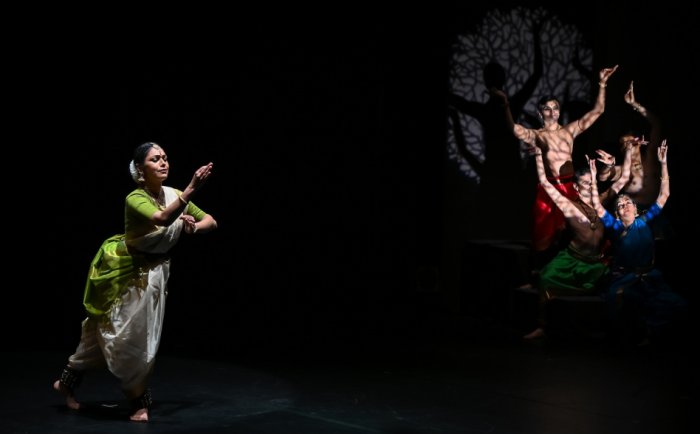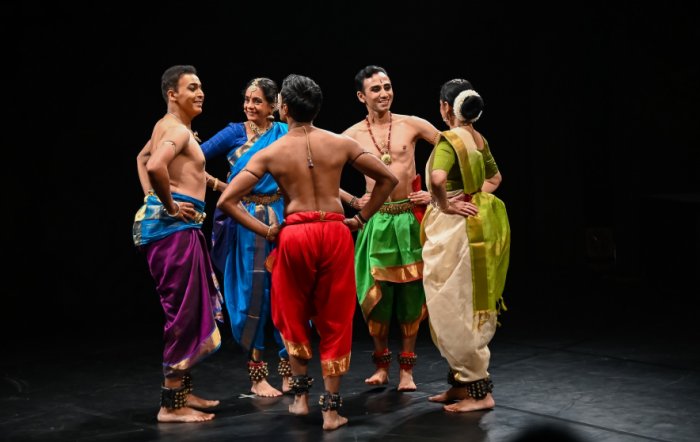
|   |

|   |
Pancha Vaakya - Five varied statements of dance - Vijay Shanker e-mail: vijaydance@gmail.com Photos courtesy: GVRNKF February 12, 2023 The evening session of the program organized by Guru GV Ramani Natya Kala Foundation (GVRNKF) and National Centre for Performing Arts at Tata theatre on December 8, featured five renowned Bharatanatyam dancers, namely Rama Vaidyanathan, Parshwanath Upadhye, Praveen Kumar, Vaibhav Arekar and Shobana Bhalchandra in a unique presentation known as Pancha Vaakya, wherein the dancers project five different statements of dance, that is structural and expressional as well, with the finale when all the dancers come together to form the oneness in thought, execution, theme, making the entire experience spiritual and philosophical too.  Pancha Vaakya is a unique medley of alarippus, composed in five marga talas by mridangist Guru Bharadwaj, in which the dancers depict the pancha bhutas and maintain the structural language of the alarippu with the completion of the item with the execution of stylized and rhythmic movements along with the recitation of verses from the Gayatri Mantra. With the concept by Rama Vaidyanathan, vocal by Krupaa Lakshmi, Mangala Vaidyanathan on violin, mridangam by Guru Bhardwaj and nattuvangam by five disciples of the respective dancers, Anita Unnikrishnan, Swarada Bhava, Shubhamani Chandrashekhar, Siri Chandrashekhar and Sanjana Rajesh. Vaibhav Arekar depicted akash (sky), Shobana incorporated water, Parshwanath portrayed fire, Praveen Kumar for earth and Rama Vaidyanathan for wind or air. It was interesting to watch as to how each dancer depicted the elements of nature, vital for existence and wellbeing in their own style and expertise. GVRNKF was instrumental in getting these artistes together and making an e-Learning course available globally to revive marga tala alarippus. Rama Vaidyanathan performed verses from the Vairagya Shatakam written by Bhartrihari, the 5th century poet from Ujjain, with music composition by Sudha Raghuraman. The dancer depicts the spiritual seeker who is disturbed by nature in different ways but the ardent devotion ultimately pays off. This again is metaphorically speaking about the human mind that is constantly seeking to be in a state of peace and tranquility. And once one reaches that state of complete equanimity and oneness with the self, does it matter if Cupid's arrows or the cuckoos cooing or the sensuous woman try to disturb the concentration? For at that state of ultimate bliss, nothing can break one's focus. The complete involvement with the theme and the perfect execution of the technique made Rama's performance truly engrossing. Leading dancer and mentor from Bangalore, Praveen Kumar incorporated verses of Leelashukha also known as Bilvamangala, one of the great poets of India. His Krishna Karanamritham has some of the finest verses described as "nectar to the ears." In the chosen verses, the poet describes how Krishna's constant intimate companion, the flute's melody triumphs in instantly bringing to a standstill the impetuous flood from the Kalindhi river. The mountains melt, the animals are captivated, and the cowherds brim in excitement, the awakening contemplation in the sages expanding the meaning of omkara. With music composition by Mahesh Swamy, Praveen took us on a mesmerizing journey to portray the magical impact of the flute on nature and existence.  Shobana depicted an extract from Kalidasa's Kumara Sambhavam that is steeped in sringara, portraying the bridal night of Shiva and Parvati in the nuptial chamber. With music composition by T.K. Padmanabhan, Shobana with the subtle netra and mukhaja abhinaya, established the intimate relationship of the divine couple. Vaibhav incorporated Bilahana, depicting the two shades of sringara, love and sadness. The idea is he remembers his beloved, a princess, and his times with her. But the fact is that he is walking towards his execution. Being a versatile performer, Vaibhav was able to capture the pathos, the suffering and the excitement of being in love in equal measure. Music was composed by Kartik Hebbar. Parshwanath Upadhye is one classical dancer who is known for his fine comic timing. An interesting extract from Amaru Shatakam, the story shows the nayaka cheating on his wife with another woman. He tries his best not to get caught, makes excuses, hides the telltale marks on his body, makes his woman hide when the nayika comes but the wife is aware of his pranks. Then there is a reversal of roles that was well enacted by Parshwanath, creating ripples in the audience. With inputs by Arjun Bharadwaj, the music composition was by Krupaa Lakshmi. The grand finale had all the five dancers come together to form a unique musical extravaganza to form unity in diversity, while seeking for the divine. A unique experiment noteworthy for its theme, execution, ideology, artistic and aesthetic sensibility.  Vijay Shankar is a Kuchipudi and Kathakali exponent, teacher, bilingual journalist, arts critic and actor. |